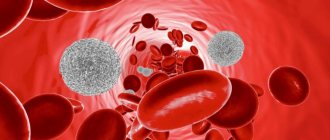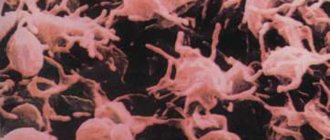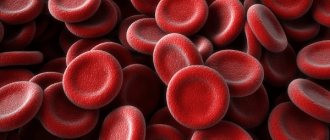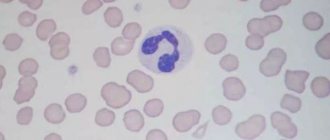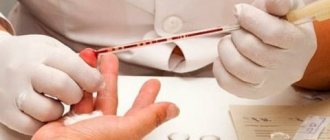General information
Leukopenia is a condition characterized by a decrease in the number of leukocytes per unit volume of blood.
It is determined if the number of leukocytes is less than 4000 in 1 μl of blood. Also, with leukopenia, the motor activity of mature neutrophils and their release into the blood from the bone marrow is impaired (this condition is called “lazy leukocyte” syndrome). The ICD-10 code for leukopenia is D72 (other white blood cell disorders). Speaking about what it means that the level of leukocytes in the blood is below normal, it should be noted that severe leukopenia is evidence of a violation of the normal process of hematopoiesis. If leukocytes in the blood are low, this means that the causes of this phenomenon may be serious pathologies. However, leukocytopenia can also develop due to other reasons - the influence of a number of drugs, radioactive exposure, lack of vitamins . This condition is sometimes associated with a hereditary factor. Sometimes the number of white blood cells can be reduced in healthy people.
Why a person can develop leukopenia, how it manifests itself, and how to treat this pathological condition will be discussed in this article.
What are leukocytes?
Leukocytes are white blood cells that vary in function and appearance. They are produced in the red bone marrow and last from several hours to several years. Their main function is to protect the body from attacks by infectious agents, foreign bodies, and foreign proteins. Leukocytes provide specific and nonspecific protection against pathogens, both external and internal.
Leukocytes are detected not only in the blood, but throughout the body, including in the lymphatic system. Their content in the blood varies at different times of the day. Their quantity also depends on the state of the body.
Some leukocytes can capture and process foreign microorganisms (the process of phagocytosis ), and another part produces antibodies .
Leukocytes are divided into several types:
- granular (granulocytes) - they, in turn, are divided into neutrophilic, eosinophilic and basophilic;
- non-granular (agranulocytes) - this category includes lymphocytes and monocytes.
The leukocyte formula is the ratio of different types of white blood cells.
Eosinophils are white blood cells that contain a bilobed nucleus and granules that stain red with eosin. These cells regulate allergic reactions.
How to increase?
Anyone wondering why their test shows low white blood cells should see a doctor.
Based on the patient’s health data, the doctor prescribes medication and recommends a certain diet. Along with this, vitamins may be prescribed. What do doctors prescribe if leukocytes in the blood are low (one of the possible options):
- blood transfusion (leukocyte mass changes);
- detoxification therapy;
- drug therapy (including antibiotics);
- individual dietary course.
To quickly increase white blood cells in the blood, a person should eat as much plant food as possible every day: citrus fruits, apricots (can be dried), prunes, pomegranate, black currants, strawberries, walnuts, propolis. From vegetables: cabbage (preferably white), beet juice, carrots, spinach, peas, beans, garlic.
With low leukocytes, it is recommended to consume as much fermented milk products as possible. The only thing to remember is that the fat content should be minimal.
Drug therapy includes:
- Methyluracil, Leukogen. They stimulate cellular metabolism, help cells regenerate, restore the humoral immune system;
- Leucomax, Filgrastim. Such drugs help in the production of monocytes (along with neutrophils) in the bone marrow.
In some cases, dietary supplements are prescribed. Alternative medicine offers other ways to solve the problem: taking horehound tincture, oatmeal decoction and regular chamomile tea.
Pathogenesis
The pathogenesis of leukopenia is determined by three main mechanisms. The essence of the first is the inhibition of the leukopoietic function of the bone marrow, as a result of which the production of leukocytes, their maturation and release into the peripheral blood are disrupted. The second mechanism is excessive destruction of cells in the vascular bed. The third is the redistribution of leukocytes in the blood and their retention in the depot organs.
Neutropenia is a process in which there is a decrease in the production of neutrophils in the bone marrow. This occurs due to impaired proliferation, differentiation and maturation of hematopoietic stem cells. This process occurs under the immune and myelotoxic influence of toxic substances and medications. It is also caused by the presence of an internal defect in the precursor cells of granulocytopoiesis, when there is a loss of their ability to differentiate into cells of the neutrophil series and at the same time the ability to normal differentiate into basophilic, eosinophilic and monocytic cells is preserved.
Bone marrow production of neutrophils also decreases due to a decrease in the bridgehead of granulocytopoiesis, which is noted when hematopoietic cells are displaced by tumor cells in patients with leukemia and carcinosis (with metastases to the bone marrow). The reason for this may also be a lack of those substances that are necessary for the normal process of proliferation, differentiation and maturation of these cells. This is a series of vitamins, amino acids , etc.
Neuropenia may also be associated with the active destruction of neutrophils, which occurs under the influence of antibodies that are formed in the case of blood transfusion due to exposure to certain medications. The mechanism of development of this condition may also be associated with the development of diseases that are accompanied by the growth of immune complexes circulating in the blood (lymphoma, tumors, autoimmune diseases, etc.). Also, the development of this condition may be associated with exposure to toxic factors during severe infectious diseases and inflammatory processes.
Neuropenia also develops as a result of too active destruction of neutrophils in the spleen. This occurs in a number of diseases, the distinctive feature of which is hypersplenism. Neutropenia as a result of the redistribution of neutrophils within the vascular bed is observed in neuroses, shock, acute malaria, etc. This condition is temporary and is replaced by leukocytosis .
Agranulocytosis is a syndrome in which neutrophil granulocytes in the blood disappear completely or almost completely. The mechanism of its development is most often associated with taking medications (sulfonamides, some antibiotics , cytostatic drugs, etc.). Often the etiological factors leading to this condition remain unknown. The origin of agranulocytosis can be immune or myelotoxic. The pathogenesis of immune agranulocytosis is based on the appearance of antibodies, the action of which is directed against one’s own leukocytes.
Why is the indicator falling?
A condition in which there is a low level of leukocytes in the blood, that is, leukopenia, can develop under the influence of a fairly extensive list of factors. The most common causes of low white blood cell counts are grouped into two groups.
Deficiency of essential substances
Often, white blood cells fall due to a lack of useful substances or microelements that are involved in the process of producing these blood components. To a large extent, this is due to poor-quality or unbalanced nutrition, and therefore the situation can be quite easily corrected by including copper, iron, zinc, iodine, folic acid and B vitamins such as B1, B12 in the diet.
Death of leukocytes
Quite often there is a reduced level of white cells due to their death directly in the bloodstream. There may be two reasons why this happens, namely:
- The introduction of an infection into the body, which causes leukocytes to rush to it to neutralize it and eliminate it. They leave the bloodstream and accumulate at the site of the lesion, which can be monitored in the laboratory by diagnosing a decrease in their concentration in the serum. At the same time, the synthesis of white cells does not decrease, and sometimes even increases, if this is required for the implementation of the protective function.
- Deviations in the activity of the bone marrow, which is the main supplier of leukocytes. In this organ they originate and then mature before being released into the bloodstream. Therefore, even the slightest disruption of the bone marrow leads to a condition in which there are few leukocytes in the blood.
The process of release of leukocytes from blood vessels into affected tissues
What causes the decrease in synthesis
There are also many reasons leading to a decrease in the production of leukocytes, and some, unfortunately, are caused by the actions of people themselves. These include the following list.
Intoxication. Harmful substances entering the human body can seriously affect many of its functions and, in particular, disrupt the normal functioning of the bone marrow. To a greater extent, this concerns poisoning with arsenic, benzene, toluene and heavy metals. In addition, alcohol and food poisoning can reduce the functional activity of the bone marrow.
Neoplasms. When metastases of a cancer tumor grow, their cells affect not only neighboring organs, but also spread through the bloodstream to others, often penetrating the bone marrow. In the process, they damage and displace tissues that provide the synthesis of leukocytes, which naturally leads to a decrease in their level. As a result, production gradually decreases or stops completely.
Chemotherapy. In oncology, for tumors developing in various organs, chemotherapy is mainly used, which negatively affects not only cancerous tissues, but also healthy cells. Therefore, after chemotherapy, there is almost always a reduced number of not only leukocytes, but also platelets, red blood cells and other blood components.
Autoimmune diseases. These pathologies lead to a negative reaction of the body not only to harmful objects, but also to its own cells. The consequences of such diseases are the destruction of white cells both in the bloodstream and in the bone marrow.
Congenital pathologies, for example, Kostman's syndrome (congenital neuropenia (decreased neutrophil leukocytes)), myelocathexis (abnormally low level of leukocytes). Radiation exposure that causes radiation sickness.
HIV. Mature and fully viable white cells actively die off during a large number of diseases, including:
- parasitic infections: toxoplasmosis, trichinosis, chlamydia;
- viral diseases (in which white cells pass from the blood into tissues, where they absorb and digest foreign elements, which leads to the death of leukocytes);
- dysfunction of the spleen and liver, since they are a kind of reservoir for blood components, and when they increase in size they tend to retain a larger number of leukocytes;
- hormonal disruptions provoked by pathology of the thyroid gland, which have a destructive effect on all cells in general and leukocytes especially suffer from this.
In addition, long-term use of certain medications has a negative effect on the viability of white cells. Decreased levels are observed with long-term therapy:
- antibacterial agents: Levomycin, Syntomycin and a group of sulfonamides;
- anti-inflammatory drugs: Reopirin, Pirabutol, Analgin and Amidopyrine;
- medications that inhibit thyroid function: potassium perchlorate, Mercazolil, Propicil.
Important! When interpreting analysis data, it is necessary to take into account the number of all types of leukocytes, as well as their ratio to each other. This information is necessary to assess the characteristics of the pathology and will help to timely adjust the therapy.
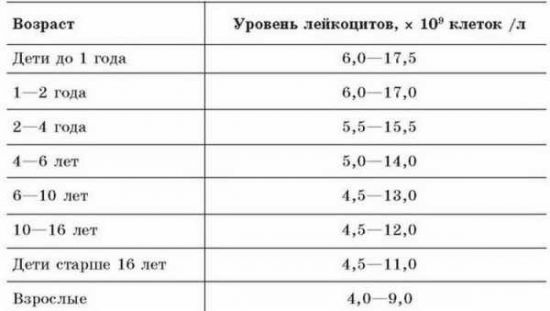
Normal white blood cell counts
Classification
If a patient has low white blood cells, this condition is classified depending on a number of indicators.
Taking into account the development mechanism, the following types of leukopenia are determined:
- Temporary (redistribution) - in this condition, leukocytes collect in the lungs and spleen.
- Constant (true) – associated with a decrease in the production of leukocytes due to a violation of their differentiation and maturation or with the accelerated destruction of leukocytes and their excretion.
Taking into account the reason for the development of this condition, the following types of leukopenia are determined:
- Infectious-toxic - develop due to the influence of poisons, the use of a number of drugs, infectious diseases, acute viral infections.
- As a consequence of the influence of ionizing radiation.
- As a consequence of systemic lesions of the hematopoietic apparatus.
- Deficient - develop due to insufficient intake of amino acids, proteins, and B vitamins into the body.
Depending on the characteristics of the course of leukopenia, the following are distinguished:
- Spicy.
- Chronic.
- Cyclic.
- Recurrent.
Depending on the type of leukocytes, the number of which decreases, the following types of this condition are determined:
- Neutropenia – the number of neutrophils decreases (< 1500/μl per microliter of blood).
- Eosinopenia – the number of eosinophils decreases (<0.05•109/l).
- Lymphopenia – there is a decrease in the number of lymphocytes (< 1000/μl).
- Monocytopenia – the number of monocytes decreases (<500/μl).
- Agranulocytosis is a condition in which granulocytopenia is noted against the background of severe leukopenia (less than 1•109/l).
In addition, the following types of this state are defined:
- hereditary and acquired;
- physiological and pathological.
Leukocytes and neutrophils: role and forms in the body, norms in the blood

Leukocytes are large white blood cells. The amount in the blood is much less than red cells. All types of leukocytes, except lymphocytes, live from several hours to several days.
The main function of leukocytes is to protect the body from foreign substances. Therefore, a decrease in their amount in the blood is dangerous for human life and health.
Leukocyte groups:
- Granulocytes - neutrophils, basophils and eosinophils.
- Agranulocytes - lymphocytes and monocytes.
The ratio and number of certain forms of leukocytes in a clinical blood test is called the leukocyte formula. Neutrophils make up up to 70% of all leukocytes. They have a granular structure and pass through capillary cells and the intercellular substance of body tissues. Due to the amoeboid nature of the movements, they are quickly directed to the infected site. Neutrophils are active phagocytes that absorb and digest pathogenic bacteria and their toxins. In this case, the cells themselves are destroyed.
Types of Neutrophils:
- stab;
- segmented.
Norms of leukocytes and neutrophils
| Indicator name | Children | Women | Men | |||
| Up to 1 year | 3 years | 6 years | 16 years | |||
| Leukocytes, *109 | 6,5—12,5 | 5—12 | 4,5—10 | 4—9,5 | 4—9 | 4—9 |
| Band neutrophils, % | 1—5 | 1—5 | 1—5 | 1—5 | 1—6 | 1—6 |
| Segmented neutrophils, % | 16—45 | 32—55 | 35—60 | 45—60 | 47—72 | 47—72 |
Fighting infection and removing dead cells are the main tasks of white blood cells and neutrophils.
Causes of leukopenia
Leukopenia in adults occurs due to a number of reasons. Therefore, when a person has low white blood cells, it is necessary to establish a diagnosis and determine the cause of the disease.
A decrease in leukocytes can be observed in the following diseases and conditions:
- Diseases of the bone marrow and blood cells - myelofibrosis , aplastic anemia , hypersplenism , myelodysplastic syndromes , myeloproliferative syndrome .
- Inherited conditions—low white blood cell counts may be present at birth. Such causes include Kostman's syndrome (congenital neutropenia) and the very rare disease myelocathexis .
- Infectious diseases - the white blood cell count decreases with tuberculosis , HIV or AIDS. This phenomenon is also typical for severe viral infections, including those that affect the bone marrow.
- Autoimmune diseases - the causes of leukocytopenia associated with such diseases are due to the fact that in such patients white blood cells or those bone marrow cells that produce them are destroyed.
- Lack of vitamins and minerals due to poor nutrition - the causes of low levels of leukocytes in the blood may be associated with a deficiency of vitamins B12 , zinc, and copper.
- The use of a number of medications - the number of white cells decreases with the use of a number of drugs, including: Clozapine , Cyclosporine , Minocycline , Sirolimus , Lamotrigine , Interferon , etc. A child may experience leukopenia after treatment with antibiotics.
- Sarcoidosis is a condition caused by an overactive immune response of the body. If granulomas form in the bone marrow, it can lead to leukopenia.
- Cancer and its treatment - leukemia and other types of cancer can lead to a decrease in the number of white blood cells due to damage to the bone marrow. Also, leukocytes below normal are detected in such patients after chemotherapy , radiation therapy, and bone marrow transplantation.
The causes of certain types of leukopenia may be associated with the following conditions:
- Neutropenia - can develop as a result of viral diseases, acute radiation sickness, bacterial infections, malaria , taking cytostatic drugs, hypersplenism, and a number of blood diseases.
- Eosinopenia is observed against the background of stress in women and men. It also develops as a result of taking glucocorticosteroids, malignant tumors, and a number of viral diseases.
- Lymphopenia – develops due to an excessive amount of glucocorticoids in the body, after radiation therapy, with immunodeficiency syndromes and lymphomas. This condition is typical for many chronic diseases. Lymphopenia is also often caused by the use of anti-lymphocyte globulin or cyclophosphamide.
- Monocytopenia - manifests itself due to excess glucocorticoids and bone marrow damage. The number of monocytes may decrease in the acute phase of an infectious disease, with exacerbation of tuberculosis , rheumatic carditis .
- Excretory leukopenia occurs with intensive emigration of leukocytes and their active elimination from the systemic circulation into the zone of chronic inflammation. A similar phenomenon is observed in chronic cholecystitis , gastritis , enteritis , inflammation of the mucous membrane of the respiratory tract, urinary and reproductive systems.
Leukocytes 3.3 - what to do?
Arsen, Minsk
15072 views
April 18, 2017
Problem: When taking blood tests - the leukocyte level was 3.3, I was tested throughout the year. White blood cells range from 2.8 to 3.3. The latest analysis for April 13 showed a leukocyte level of 3.58. That is, the indicator improved by 8% compared to the previous time. Why am I contacting you: I ask for advice on further actions to increase my immunity and, in particular, the level of leukocytes. Clinic: No manifestations or pain. The only thing that can be noted is fatigue. (Fatigue compared to other people is about 30-40% more, but this could also be due to workload, daily routine, etc.) I’m not sick at all. Over the past few years, I have had a cold a couple of times. That is, I get ARVI about once every 2 years. I don't get sick anymore. Possible diseases and viruses: HIV\AIDS\Cirrhosis\Hepatitis\Venereal - no, never happened. No serious viruses or infections were detected, I took many tests. Candida was found in an insignificant form (they did a smear of the head of the penis). Streptococci/staphylococci were also found in the microflora of the nasopharynx in an insignificant form. Stomach: Although there are no manifestations in the form of nausea, pain, or heartburn, Helicobacter 2+ is present in the stomach. There is also gastritis and reflux. Lungs: Respiratory volume is normal. No viruses detected. No bulls were found. There is tissue fibrosis. (There is also a CT scan in electronic form, which I can provide.) Heart: Mitral valve prolapse (the mildest degree. If necessary, I will pull up the documents and tell you exactly) Immune system: I had a bone marrow puncture in 2021. The bone marrow produces white blood cells at normal levels. I can also attach the results. Oncology – no malignant cells were detected. My characteristics: male 11/12/1990 fair skin, blond height: 178 cm thin, weight 62 kg, at the same time wiry and with muscles. I have been involved in sports for a long time. Bad habits: I smoked for about 3 years straight. Daily doses of cigarettes are approximately 2-4 pcs. I haven't smoked for 1.5 years now. I don't use drugs or alcohol at all. Previous illnesses: 1. In the first year of my life I had bilateral pneumonia. 2. As a child, I had ARVI every winter, and I also had sinusitis. At the age of 16 he was completely cured. 3. At the age of 15, the temperature remained at 37.2 for approximately 5-6 months and did not subside. As soon as I got up on my own, six months later I slept to the norm of 36.6. The reasons have not been identified. 4. In 2012, spontaneous pneumothorex occurred on the left side. There were no further manifestations of pneumothorex. I had a CT scan last year - no bullae were found. Nutrition and sleep standards: I sleep at least 8 hours a day. I eat a variety of foods. First, second, third. Not a vegetarian. I eat 3-4 times a day. I drink plenty of good still water. By the way, throughout my entire life, I have never had such a feeling as hunger. I eat because I have to. History of leukocyte level: In childhood, the level was normal. From the age of 18 I was almost never tested, since there was no reason for this. In 2012, when spontaneous pneumothorax occurred, when taking tests in the hospital, the indicator was 4.7. In 2021, I decided to get checked, the leukocyte level was 3.3. 3 months ago I took a course of Macmiror (2 weeks, 800g each), since the girl with whom I have been in a relationship for a year has been constantly tormented by candida. (I never had external manifestations) The course helped the girl - candida does not arise. Having checked my leukocytes now, the leukocyte level rose to 3.58 for the first time this year. My conclusion: I was examined by a therapist, immunologist, hematologist, pulmonologist, gastroenterologist - the answer is basically the same for everyone: “If there is no clinic, then there is nothing to treat. Your immune system is in a borderline state - it will either go up and improve, or go down and get worse. When the clinic starts to worsen, then contact us - we will treat you, but now eat well, sleep and continue to lead a healthy lifestyle."
The question is closed
immunity
leukocytes
leukopenia
Symptoms of leukopenia
At the very beginning, the symptoms of leukopenia, as a rule, are not pronounced. However, over time, the pathology is reflected in cellular and humoral immunity , which leads to a general deterioration in the function of the immune system. During this period, cytopenia can provoke the development of the following symptoms:
- dizziness;
- headache;
- itching;
- feeling tired and weak;
- chills;
- sweating;
- rapid pulse;
- anxiety;
- increased body temperature;
- signs of exhaustion.
If a person has few white blood cells in the blood due to the use of certain medications, then the symptoms increase very quickly.
Subsequently, the patient's glands may swell. Later, the tonsils and spleen enlarge, and trophic ulcers . These signs are accompanied by symptoms of diseases that result in cytopenia .
The clinical manifestation of agranulocytosis is ulcerative necrotic tonsillitis as a result of suppression of the body's defense reactions.
Symptoms
Women should not worry about a slightly reduced number of leukocytes in the blood. If the indicators do not drop below 3.4-9*109 U/l and the condition is not accompanied by any symptoms, then it is enough to repeat the analysis after a couple of weeks. Perhaps these are residual effects from a cold or a reaction to some allergen.
To complete the picture, it is recommended to do an analysis with a complete count of the leukocyte formula, which will help the doctor understand why immune cells are low. Unlike elevated levels (leukocytosis), a decrease in white cells is much easier to recognize.
If white blood is not produced in sufficient quantities, the body gradually loses the strength to fight pathogens or toxins. Therefore, a sign of a long-term decrease in leukocytes in the blood in women, as well as in men, will be the presence of infectious diseases.
Reference! According to numerous statistics, if leukopenia is observed for more than two weeks, the infection affects patients in 100% of cases.

Increased body temperature may be a consequence of low white blood cell levels
The manifestations of this condition directly depend on the degree of decrease in the indicator. If it deviates slightly from the reference values, then such leukopenia will be asymptomatic, while too low leukocytes will be accompanied by a significant and rapid deterioration in well-being.
How to quickly increase leukocytes in the blood?
Therefore, if a woman has the following symptoms:
- increase in body temperature,
- headaches, pallor,
- chills, fever,
- shortness of breath, tachycardia,
- increased sweating,
- loss of strength, severe weakness,
- general exhaustion of the body,
then there is a high probability that the leukocytes in the blood are below normal, and this condition has already reached a very dangerous stage. Sooner or later, in the absence of adequate treatment, the woman’s well-being will worsen. Symptoms of poor immune defense will appear, namely:
- bleeding gums;
- ulcers on the mucous membranes of the mouth;
- herpetic rash on mucous membranes;
- enlarged tonsils, spleen;
- exacerbation of chronic diseases;
- fungal infections, skin infections;
- damage to the digestive system;
- respiratory tract infections (tonsillitis, pneumonia, pharyngitis), etc.
If the level of leukocytes in the blood drops critically, the body cannot resist infections, and even simple acute respiratory viral infections become very dangerous for it. To find out the cause of frequent colds and infectious diseases, it is necessary to take a detailed blood test with a complete decoding of the leukocyte formula.
Tests and diagnostics
To determine the number of leukocytes, a complete blood count is performed. If necessary, an additional study is also carried out with the differentiation of leukocytes in order to determine which white cells have a reduced number. In this way, you can exclude the probable causes of the development of leukopenia and move on to a more accurate diagnosis.
During the diagnostic process, leukopenia can be determined using the following studies:
- Hemogram - makes it possible to determine the absolute number of red blood cells, platelets, leukocytes, as well as determine the percentage of types of white cells.
- Immunological blood test - to determine anti-granulocyte and antinuclear immunoglobulins.
- Cytological examination allows one to differentiate leukopenia and establish the mechanism of their development.
- Biochemical blood test - determines the content of folate, cyanocobalamin, liver transaminases, bilirubin .
- Serological markers of hepatitis B and C.
A blood test for rheumatoid factor may also be done.
To get the most reliable result, repeat tests are carried out after some time.
Diagnostics
The diagnosis of “leukopenia” is made based on the patient’s complaints, anamnesis (heredity, current and past diseases), upon examination (enlarged lymph nodes, weight loss), and according to the results of laboratory tests.
Diagnostic tests for low levels of leukocytes in the blood:
- Ultrasound of the peritoneal organs - enlargement of the liver, spleen,
- Serological and biochemical blood test,
- Clinical blood test - a decrease in the level of leukocytes in the blood below normal,
- Spinal puncture (collection of cerebrospinal fluid using a syringe).
Leukopenia in children
First of all, it is important to take into account that in children the number of peripheral blood leukocytes directly depends on age. Therefore, leukopenia is determined if the child’s leukocytes are reduced by 30% from the average age norm.
Low white blood cells in a child’s blood can be detected in the following cases:
- For congenital immunodeficiency diseases of thymic origin.
- In the case of viral and some bacterial infections, as well as severe toxic and viral conditions accompanied by bone marrow suppression.
- With Shwachman-Diamond syndrome , a rare hereditary disease that causes pancreatic dysfunction and congenital neutropenia .
- With Kostman's syndrome, congenital severe neutropenia is noted, since neutrophils in this disease do not mature, as they should normally.
- For a number of other diseases, including: chronic granulomatous disease, myeloperoxidase , leukocyte adhesion deficiency, Chediak-Higashi syndrome .
- Also, leukopenia in children develops as a result of radiation therapy and chemotherapy, taking certain medications, autoimmune diseases, HIV, hepatitis .
When the white blood cell count is low, children may experience the following symptoms:
- Frequent development of infectious diseases affecting the lungs, paranasal sinuses, and ears.
- Mouth ulcers.
- abscesses .
- Periodontal disease.
- Fungal diseases.
- If there is a lack of leukocyte adhesion, wound healing slows down.
- Shwachman-Diamond syndrome causes chronic diarrhea , sometimes fatty.
Treatment methods
What to do if leukocytes in the blood are low? The most important method of increasing the number of white cells in the blood is to follow a therapeutic diet. The diet should be enriched with B vitamins, amino acids, choline, proteins, while limiting the consumption of carbohydrates.
The following products should be present in the diet:
- Grenades,
- Raw vegetables, herbs, fruits, berries, in particular red ones,
- Chicken eggs,
- Seafood,
- Oats, buckwheat,
- Legumes,
- Beet juice,
- Dry red wine,
- Walnuts,
- Caviar.
Drug treatment:
- Multivitamin complexes: folic acid, thiamine, pyridoxine.
Folic acid, 1 tablet twice a day,
- Agents that stimulate the production of white cells: methyluracil, pentoxyl, leucogen.
Leukogen, 1 tablet 3 – 4 times a day,
- Means to strengthen the immune system: tincture of Eleutherococcus, Echinacea.
Eleutherococcus tincture, 20 – 30 drops per glass of water,
- Agents that enhance the production of leukocytes by the bone marrow: filgrastim, leucomax.
Leukomax, 1 capsule three times a day,
- Immunostimulants - to strengthen the immune system: comedon, immunal, estifan.
Immunal, 1 tablet 3 – 4 times a day.
The medications and course of treatment are prescribed by the doctor!
During pregnancy
During pregnancy , leukopenia can develop due to various reasons. The danger of this condition during pregnancy, first of all, is that diseases that provoke a decrease in the level of leukocytes can affect the baby. Pathological conditions can lead to miscarriage and premature birth. Therefore, it is important for the expectant mother to regularly conduct blood tests in order to detect pathology in a timely manner. Regular blood tests of a pregnant woman also make it possible to identify other pathological indicators (lymphocytes are elevated, monocytes are elevated, etc.) and promptly prescribe treatment.
As a rule, when the level of leukocytes in pregnant women is low, the doctor prescribes treatment, depending on the pathology that provoked the problem.
It is important for the expectant mother to eat well, prevent the development of bacterial and infectious diseases, not overwork and lead an active lifestyle.
Leukopenia - symptoms of the disorder
Due to too few white blood cells, that is, leukopenia, the body's immunity is greatly weakened. The fewer leukocytes, the higher the susceptibility to bacterial, viral, fungal, as well as protozoal and amoebic infections.
Mild leukopenia does not always produce symptoms and not in everyone. A slight decrease in white blood cell levels may not affect the functioning of the immune system if it is short-term. However, depending on the individual characteristics of the body, the effects of leukopenia can be noticeable even with a slight decrease in the level of leukocytes.
Symptoms of leukopenia:
- weakness, fatigue
- problems concentrating
- nausea and vomiting
- frequent infections
- aphthae and other ulcerative changes in the oral cavity
- purulent skin lesions
- increased body temperature or fever
- swollen lymph nodes
- pneumonia
- headache
- emotional disorders
- anemia
- long and heavy menstruation
- liver abscesses
In severe cases, leukopenia can result in death if the body completely loses resistance to infections. Then, even a seemingly harmless infection can lead to death.
Diet
Diet for anemia
- Efficacy: no data
- Time frame: 3 months
- Cost of products: 2700-3200 rubles. in Week
With leukopenia, the patient should introduce the following products into the diet:
- Berries, fruits, vegetables, herbs.
- Whole grain porridge.
- Veal, rabbit, poultry.
- Nuts, honey, especially honey in combs.
- Legumes.
Under no circumstances should you adhere to low-calorie diets or fast, as this can only worsen the condition.
Consequences and complications
With a chronically low white blood cell count, the body becomes vulnerable to infectious diseases. In this condition, the immune system suffers, as a result of which the body’s protective functions are weakened.
With leukopenia, the likelihood of developing a tumor disease increases.
Another serious complication of this disease is agranulocytosis (a sharp decrease in granulocytes in the blood) and aleukia (bone marrow damage with inhibition of hematopoiesis and lymphopoiesis).
List of sources
- Abdulkadyrov K.M. Hematology. Newest reference book / K.M. Abdulkadyrov - M.: Eksmo, 2004. - 928 p.
- Zaiko N.N. Pathological physiology / N.N. Zaiko [and others]; edited by N.N. Zayko. – Moscow, 2006. – P. 351-358.
- Chesnokova N.P., Nevvazhay T.A., Ponukalina E.V., Zhevak T.N., Polutova N.V., Bizenkova M.N. Lecture 1 Leukopenia: general characteristics, etiology, pathogenesis, features of hematological changes // International Journal of Experimental Education. – 2015. – No. 7. – P. 178-180
- Chesnokova N.P., Nevvazhay T.A., Ponukalina E.V., Zhevak T.N., Polutova N.V., Bizenkova M.N. Lecture 2 Acquired leukopenia: classification, etiological factors, significance in the development of pathology // International Journal of Experimental Education. – 2015. – No. 7. – P. 180-183
